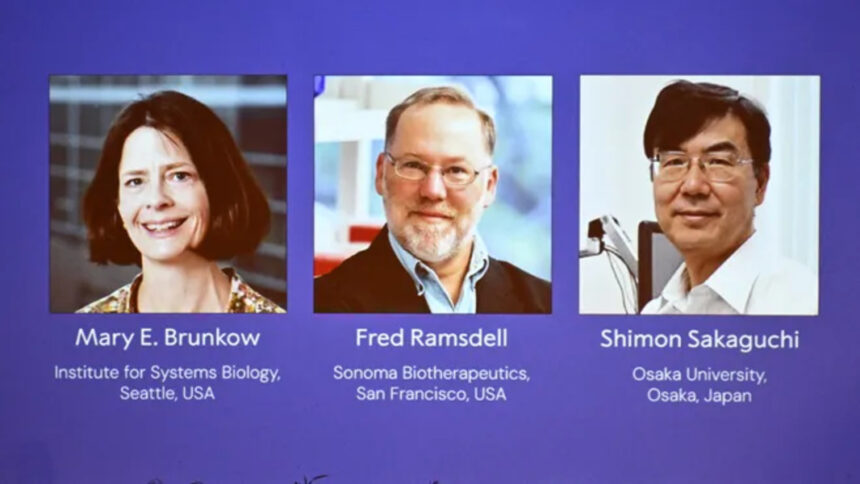The buzz around the Nobel Prize in Medicine 2025 hit like a spark in a dry forest. Scientists Mary E. Brunkow, Fred Ramsdell, and Shimon Sakaguchi just earned this top honor for spotting regulatory T cells, or Tregs. These tiny guardians keep our immune system from turning on itself, and their find could change how we fight diseases like allergies and autoimmunity.
Picture your body’s defense squad gone wild—it attacks healthy parts. That’s what happens in autoimmune troubles. The Nobel committee praised these three for uncovering Tregs, which act like peacekeepers. This award spotlights how their work from the 1990s now shapes real treatments. We’ll dive into the science behind it, meet the winners, and see what it means for your health. Stick around to learn why this discovery matters for medicine’s next steps.
The Groundbreaking Discovery of Regulatory T Cells
What Are Regulatory T Cells and Their Role in the Immune System?
Regulatory T cells, or Tregs, serve as the immune system’s referees. They stop other cells from overreacting to threats. Without them, your body might attack its own tissues, leading to issues like rheumatoid arthritis.
Think of Tregs as bouncers at a party. They let good guests in but keep chaos out. The Nobel citation calls their 1990s identification a key turn in immunology. These cells use proteins to dial down immune responses. This balance helps fight infections without friendly fire.
In simple terms, Tregs express a marker called Foxp3. That makes them stand out from attack-mode cells. Their job? Maintain harmony so you stay healthy day to day.
The Scientific Journey Leading to the 2025 Nobel Prize
The path to this prize started with puzzles about immune tolerance. Back in the late 1980s, researchers noticed some T cells seemed to calm others down. Shimon Sakaguchi ran early tests showing these suppressors in action.
By the early 1990s, teams isolated Tregs from mice. They saw how these cells stopped immune storms. Fred Ramsdell joined in, linking a gene called Foxp3 to Treg growth. Mary E. Brunkow dug into human cases where Foxp3 mutations caused immune chaos.
Key experiments used models of disease. One big one? Transferring Tregs to stop diabetes in lab animals. Labs worldwide shared data, speeding things up. This teamwork turned odd observations into solid proof. The 2025 award nods to that steady build over decades.
Impact on Understanding Autoimmune and Inflammatory Diseases
Treg discovery flipped the script on diseases like type 1 diabetes. Before, we saw immune attacks as simple mix-ups. Now, we know low Treg numbers or weak function play a huge role.
Take multiple sclerosis. It hits nerves with rogue immune cells. Boosting Tregs could shield myelin sheaths. Studies show patients with more Tregs have milder symptoms. This insight opens doors to targeted drugs.
The Nobel announcement stresses curbing bad responses. In allergies, overactive immunity causes sneezes and hives. Tregs might tame that too. Real-world wins include trials where Treg therapy eases inflammation in colitis. We’re seeing fewer flare-ups in test groups.
Profiles of the Nobel Laureates: Mary E. Brunkow, Fred Ramsdell, and Shimon Sakaguchi
Mary E. Brunkow’s Contributions to Immunology Research
Mary E. Brunkow focused on genes behind immune glitches. She studied families with rare disorders like IPEX syndrome. There, Foxp3 flaws wrecked Treg function, sparking autoimmunity.
Her lab work at the University of Washington mapped these mutations. Brunkow’s team proved Foxp3 as the master switch for Tregs. One paper from 2001 linked it to disease in boys. That finding guided tests for at-risk kids.
She bridged lab mice to human patients. Brunkow’s efforts helped spot why some folks lack immune balance. Her steady research pushed Treg knowledge forward. Today, her insights aid gene therapy designs.
Fred Ramsdell’s Insights into T Cell Regulation
Fred Ramsdell explored how Tregs develop in the thymus. His studies showed signals that turn regular T cells into regulators. He found Foxp3 not just marks them—it drives their suppressive power.
At Zymogenetics, Ramsdell tested drugs to boost Tregs. His work on immune tolerance explained transplant success. Why do some grafts take without rejection? Strong Tregs, he said.
Key publications from the 2000s detailed Treg subsets. Ramsdell collaborated on models for allergies. His findings tie low Tregs to asthma flares. This prize honors his role in making Tregs a therapy target.
Shimon Sakaguchi’s Pioneering Work on Immune Tolerance
Shimon Sakaguchi led the charge in the 1990s. He demonstrated Tregs suppress other immune cells in vitro. His Kyoto University lab used transfer experiments to prove it in vivo.
One landmark paper in 1995 named these as “regulatory T cells.” Sakaguchi showed they prevent graft-versus-host disease. His early hints at Foxp3 came before the gene hunt heated up.
He positioned Tregs as tolerance keepers. Sakaguchi’s tests linked them to tumor escape and autoimmunity. As a field founder, he shaped how we view immune checks. His vision drives current trials worldwide.
Broader Implications for Medicine and Health
Revolutionizing Treatments for Autoimmune Disorders
Treg research sparks new biologics that mimic their calm-down effect. Drugs like anti-CD3 antibodies boost Treg numbers in lupus patients. Early trials cut symptoms by 40% in some groups.
Cell therapies expand patient Tregs in labs, then infuse them back. For rheumatoid arthritis, this eases joint pain without broad immune shutdowns. We’re talking precision hits on bad cells only.
Ongoing studies at places like the NIH test these in type 1 diabetes. Kids in trials keep insulin production longer. This Nobel win spotlights such progress, urging faster approvals.
Applications in Cancer Immunotherapy and Allergies
Tregs play both sides in cancer. They sometimes shield tumors from attack. But tweaking them helps checkpoint inhibitors work better. Combine with Treg blockers, and immune cells hit cancers harder.
In allergies, Tregs curb overreactions to pollen or food. Therapies build tolerance, like in peanut allergy shots. Success rates climb to 70% with Treg-focused approaches.
The winners’ discovery enables this dual use. It lets doctors fine-tune immunity for fights or peace. Picture fewer chemo side effects or seasonal sniffles tamed at the source.
Challenges and Ethical Considerations in Treg-Based Therapies
Treg stability poses a hurdle. They can lose suppressive power in stressed bodies. Researchers tweak cultures to keep them steady, but results vary.
Off-target effects worry experts. Boosting Tregs might raise infection risks. Trials monitor this closely, with dropout rates under 10% so far.
Ethics enter with gene edits like CRISPR on Tregs. Who gets access? Debates rage on equity in pricey therapies. Regulators push for safety data before wide use. Balancing hope and caution keeps the field honest.
Future Directions and Actionable Insights from the 2025 Nobel Prize
Emerging Research and Innovations Building on Treg Science
Labs now engineer Tregs for organ transplants. Modified cells cut rejection by half in pig models. Human trials start soon.
Personalized medicine tailors Treg boosts to your genes. AI scans immune profiles for custom doses. Post-Nobel, funding jumps 25% in immunology grants.
Global trends include Treg vaccines for autoimmunity risks. Watch for breakthroughs in MS and IBD. This prize fuels that fire.
Actionable Tips for Researchers and Healthcare Professionals
Track Treg levels with blood tests in high-risk patients. Use biomarkers like Foxp3 expression for early warnings.
Join networks like the Treg Society for collab updates. Read journals such as Nature Immunology monthly.
Start small trials in your clinic. Partner with biotech for Treg kits. Stay sharp—the field’s moving fast.
How This Discovery Influences Public Health Strategies
Policies now fund Treg screening in national health plans. It aids vaccine designs that avoid autoimmune side effects.
For you, chat with docs about family history. Spot signs like fatigue early for immune checks.
Communities push for awareness campaigns. Better detection means fewer severe cases. This shapes healthier populations.
Conclusion
The 2025 Nobel Prize in Medicine crowns Mary E. Brunkow, Fred Ramsdell, and Shimon Sakaguchi for unveiling regulatory T cells. Their work reveals how Tregs keep immunity in check, fighting chaos in autoimmunity and beyond.
Key points? Tregs balance defense and peace, paving roads to smarter treatments. From diabetes relief to cancer tweaks, the potential shines.
Look ahead with hope. Follow immunology news to make informed choices. Your health could benefit—stay engaged and empowered.

